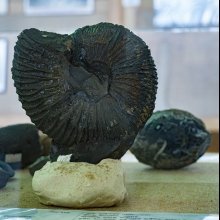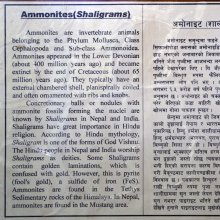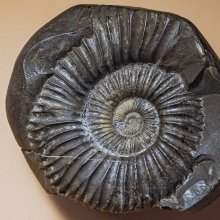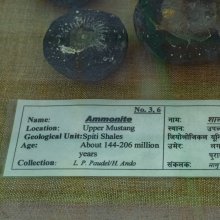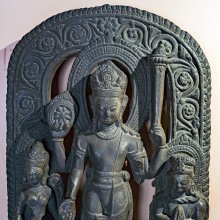Shaligram, Śāligrām: 4 definitions
Introduction:
Shaligram means something in Hinduism, Sanskrit. If you want to know the exact meaning, history, etymology or English translation of this term then check out the descriptions on this page. Add your comment or reference to a book if you want to contribute to this summary article.
Images (photo gallery)
In Hinduism
General definition (in Hinduism)
Source: WikiPedia: HinduismShaligram refers to a Vaishnava (Hindu) aniconic representation of Vishnu, in the form of a spherical, usually black-coloured Ammonoid fossil found in the sacred river Gandaki.
The Shilas (Ammonite fossils) are worshipped as manifestations of Vishnu himself, identifiable from other stones by special markings which resemble Vishnu's paraphernalia such as mace, conch, lotus and disc (chakra). Narasimhadeva, Varahadeva and Vamanadeva are popular forms of worship. They are either black, red, or mixed in colour and are usually kept closed in a box and are only brought out for daily worship (puja). The Shilas are usually hereditary and are passed down through many generations, never being purchased or sold.
Historically, the use of Shaligrama (or Salagrama) Shilas in worship can be traced to the time of Adi Shankara through the latter's works. Specifically, his commentary to the verse 1.6.1 in Taittiriya Upanishad and his commentary to the verse 1.3.14 of the Brahma Sutras suggest that the use of Saligrama in the worship of Vishnu has been a well-known Hindu practice.
etymology: Shila, (शिला in Devanagari, śila in IAST) or Shaligram. The word Shila translates simply to 'stone' and Shaligram is a less well-known name of Vishnu. The origin of the name is traced to a remote village in Nepal where Vishnu is known by the name of Shaligraman. Shaligram in Hinduism is also known as Salagrama. The name Salagrama refers to the name of the village on the bank of Gandaki where the holy stones are picked up. The name is derived from the hut (sala) of the sage Salankayana, who beheld the form of Vishnu in a tree outside his hut (cf. Varaha-purana).
Source: Nepali Shaligram: Sri Shaligram ShilaSri Shaligram is Mostly black holy stone found in Sacred River Gandaki and Muktinath in Nepal. Even though mostly shaligrams are black in colors and black are usually worshipped in every home and Temples. Sometime other rare color of shaligram like blue,green ,white and others are also found.
The Sacred shaligram stones are worshipped in Everyone House and Temples. Shaligram is direct symbol of God vishnu (Narayan). God vishnu is also known as Patron or main Hindu god. He is also known as Protecter of creation,where as Lord brahma the creator and Lord shiva destroyer of Evil in this big creation of World. There are also Various types of shaligram which are associated with different names and incarnation of god vishnu.
Shaligram is also known as Shaligram shila. The "shila" meaning the sacred form of lord in Self appeared deity form or represent deity when we establish in specific home or temples.
Source: Rudraksha: About SaligramThe Shaligram is the most sacred stone worshipped by the Vaishnavas and is used to worship Vishnu . According to shastra worship Shree Shaligram for six values of life ;- Righteous living, Wealth, Protection, good health, pleasures and Spiritual blessing .
Languages of India and abroad
Nepali dictionary
Source: unoes: Nepali-English DictionaryShaligram is another spelling for शालिग्राम [śāligrāma].—n. 1. a black stone found in the bank of Kali river; 2. a black stone worshipped as Vishnu by the Hindus;
Nepali is the primary language of the Nepalese people counting almost 20 million native speakers. The country of Nepal is situated in the Himalaya mountain range to the north of India.
See also (Relevant definitions)
Starts with: Shaligrama.
Query error!
Full-text: Shila, Shaligrama, Kshetra.
Relevant text
Search found 13 books and stories containing Shaligram, Śāligrām, Saligram; (plurals include: Shaligrams, Śāligrāms, Saligrams). You can also click to the full overview containing English textual excerpts. Below are direct links for the most relevant articles:
International Ayurvedic Medical Journal
A critical review of varuna (crataeva nurvala) < [2018, Issue VI, June]
A critical review of mundi (sphaeranthus indicus linn) < [2018, Issue VI, June]
Literary review of three herbs (brahmi, sankhapuspi, jatamanshi) use for promotion of medha (intellect) < [2021, Issue 10, October]
World Journal of Pharmaceutical Research
Review of Moringa oleifera Lam. focusing on Nighantus. < [2022: Volume 11, January issue 1]
Daruharidra (berberis aristata, dc.) w.s.r. to nighantu (indian lexicon) < [2015: Volume 4, November issue 11]
Review of Cedrus deodara (Roxb.) Loud. with a focus on Nighantus. < [2022: Volume 11, May issue 5]
Bhaktavijaya: Stories of Indian Saints (by Justin E. Abbott)
23.3: Leather (or skin) all over creation < [Chapter 25 - Rohidas the shoemaker]
23.4: The Brahman’s pride humbled < [Chapter 25 - Rohidas the shoemaker]
37.4: Dayarnava’s villages confiscated < [Chapter 37 - Rasik Murar]
Garuda Purana (by Manmatha Nath Dutt)
Chapter XLV - Characteristic marks of Shalagrama Stones (Shaligram) < [Agastya Samhita]
Meda, key astavarga member, faces identification and standardization issues. < [Volume 7, Issue 4: July - August 2020]
Identifying Jalakumbhi in Ayurveda: A Critical Literature Review < [Volume 9, Issue 1: January-February 2022]
Critical study of medicinal plants in Durga Saptasati. < [Volume 8, Issue 1: January - February 2021]
